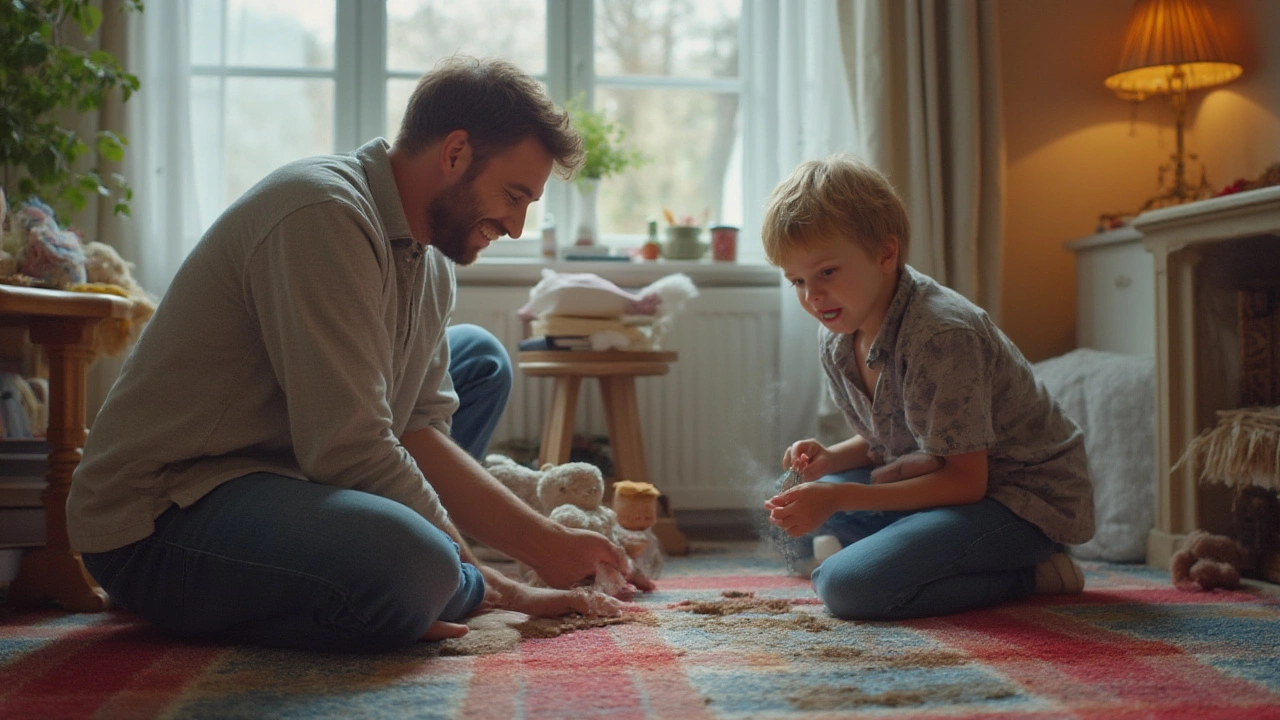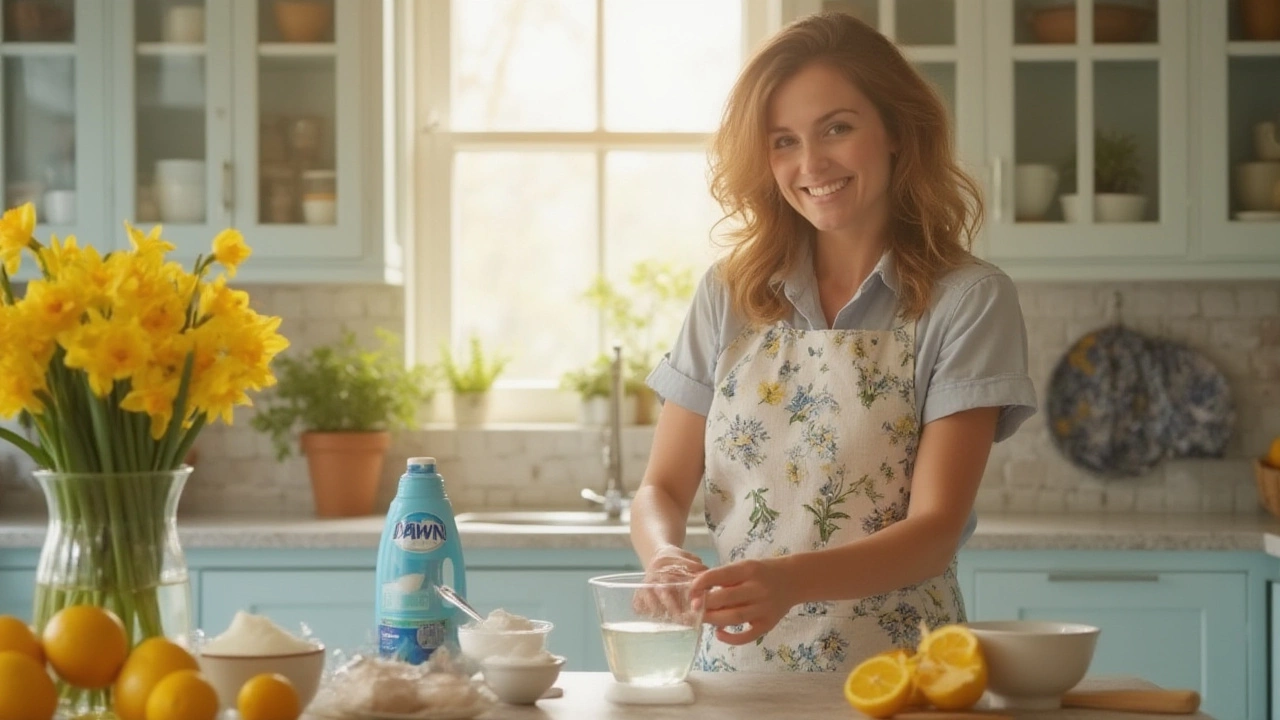Think you need a shelf full of fancy cleaners for a spotless home? Nope. Just three kitchen staples—vinegar, Dawn dish soap, and baking soda—can handle most of the messes life throws your way. And the best part? These ingredients aren’t just budget-friendly; they’re safe for most surfaces, kinder to you and your pets than super-strong chemicals, and surprisingly powerful when you know how to use them right. Cleaning doesn’t have to mean harsh smells and sticky residues—sometimes, the gentle stuff packs the biggest punch.
Why Vinegar, Dawn, and Baking Soda Work So Well Together
Ever wondered why this trio of vinegar, Dawn, and baking soda is all over cleaning forums and TikTok videos? Science is the answer. Vinegar (specifically white distilled vinegar) brings a punch of acidity, which breaks down grease, dissolves limescale, and makes hard water stains vanish. Baking soda, or sodium bicarbonate, is a mild abrasive that can scrub off stubborn build-up—think of it as a gentle sandpaper that won’t scratch most surfaces. Dawn, a leading dish soap, is famous for its grease-cutting power. When these three work together, you’ve got a combo that attacks stains from all sides.
Put them in the right order, and you get sparkling kitchens and bathrooms with minimal fuss. Here’s something people get wrong: Don’t just dump vinegar and baking soda together in hopes of a volcano effect scrubbing away your bathroom mold. That fizzy reaction looks cool, but it quickly neutralizes the cleaning power of both. Instead, layer your ingredients—let one sit, wipe, then follow up with another. This way, each brings out the best in the others.
For example, your kitchen sink: Sprinkle it with baking soda, scrub with a sponge, rinse. Follow up with a mixture of vinegar and water, spray thoroughly, let it fizz for a moment, then rinse again. Spots and scents vanish. Dawn gets added to the mix for greasy pans, stovetops, or anything with a sticky, oily mess. Add a few drops to vinegar in a spray bottle—suddenly, you’ve got a solution that cuts through grease without leaving a film. Even the U.S. Environmental Protection Agency nods to vinegar as a safer cleaning alternative (but don’t drink it or use it on every type of stone!).
By the way, if you’re worried about the safety of mixing these ingredients, relax—there’s nothing toxic about their combo when used correctly. Just don’t inhale the vinegar fumes directly (open a window if you’re feeling woozy), and skip marble or granite surfaces since vinegar’s acid can dull the finish. Got wood floors? Stick to a water-and-vinegar solution, well-diluted, and skip the baking soda there.
Since 2020, interest in natural cleaners has skyrocketed. More people at home notice what’s really in their store-bought bottles—and decide to ditch them for the old-school stuff. Science and nostalgia make a great pairing here.
Best Recipes and Ratios: Making the Magic Mixtures
Let’s get concrete. Here are battle-tested recipes for mixing vinegar, Dawn, and baking soda, so you don’t end up with a gooey mess or streaky surfaces. You can tailor these recipes to specific messes—don’t worry, no fancy gadgets or chemistry degrees needed. I’ll start with the classic tub and shower cleaner, because honestly, nothing breaks through soap scum quite like this combo.
- Tub and Shower Spray:
Mix 1 cup of white vinegar and 1 cup of Dawn in a spray bottle. Heat the vinegar first until it’s hot (don’t boil it) for best results, then pour it into the bottle over the soap. Shake gently. Spray it liberally on your tub, tiles, and shower doors. Let it sit for at least 30 minutes—longer if you see stubborn stains or pink mold. Then wipe and rinse. The hot vinegar softens mineral deposits and grime, while the Dawn dissolves the sticky soap residue. I’ve used this on ten-year-old tubs that looked hopeless—always delivers a shiny result. - Toilet Bombs:
Want to scrub less? Drop 1/2 cup of baking soda straight into the bowl. Pour in 1/2 cup white vinegar and watch the fizz. Let it bubble for at least five minutes, then flush or scrub if you’ve got stuck-on gunk. No one wants to spend their evening wrestling with toilet stains, right? - Grease-Busting Spray:
Add 2 cups of water, 1/2 cup vinegar, and a few drops of Dawn to a spray bottle. Spray directly on kitchen surfaces caked with grease—like range hoods or oven doors. Let sit, then wipe with a damp cloth. - Carpet Spot Remover:
For fresh stains, sprinkle baking soda over the spot. Let it absorb for 10–15 minutes, then vacuum. Next, dab with a mix of 1 cup warm water, 1/4 cup vinegar, and a few drops of Dawn. Blot (don’t rub!) with a clean towel. This trick saved our beige carpet after Isla’s epic coffee spill during a Monday morning rush. - Microwave Cleaner:
Place a bowl with 1 cup vinegar and 1 cup hot water inside, and microwave on high for 2 minutes. Let it sit with the door closed for five. The steam loosens gunk, and you can wipe away splatters easily. For stubborn bits, sprinkle a bit of baking soda on a sponge and scrub gently.
Remember, never mix vinegar with bleach, as this creates dangerous fumes. But baking soda and vinegar are safe, as long as you rinse after. These recipes work for most surfaces, but always test a small hidden area first, especially on painted or delicate materials.

Unexpected Uses and Smart Shortcuts
Think vinegar, Dawn, and baking soda are just for sinks and showers? They shine way beyond the basics. How about smelly sneakers? Sprinkle dry baking soda inside and shake out in the morning—no more funk. For cloudy glassware, soak in a mix of warm vinegar and water. Spots disappear, and your glasses sparkle like new.
Dishwasher a bit stinky or cloudy? Place a cup of vinegar on the top rack and bake a cleaning cycle—with no dishes. Every two months, toss a handful of baking soda in the bottom and run a hot-water cycle to freshen up. This isn’t magic—acids break down limescale, while baking soda neutralizes odors and soap scum. Even studies from appliance makers like Whirlpool confirm you don’t need harsh cleaners here.
Sneaky use: mix vinegar and water 1:1 in a spray bottle for windows and mirrors. A touch of Dawn helps cut greasy fingerprints. Spray and buff with a microfiber cloth. This outperforms a lot of glass sprays in supermarket aisles, and wipes out fingerprints from curious toddlers or, in our house, pancake syrup stains from a hurried school run.
Stuck-on food in pots and pans? Cover the mess with baking soda. Sprinkle a tiny bit of water to form a thick paste. Let it sit for half an hour, then scrub. If you need extra muscle, add a squirt of Dawn and some hot vinegar and let it simmer for a few minutes. Works on gunky oven racks and barbecue grates, too.
Banish garbage disposal odors: Pour in 1/2 cup baking soda, then 1/2 cup vinegar. Let it fizz, then flush with hot water while running the disposal. Garlic and onion smells don’t stand a chance. Even better, this keeps the blades and pipes cleaner, so your kitchen doesn’t develop a mystery stink after family taco night.
Washing machine got a whiff? Run an empty cycle with hot water and two cups of vinegar. If it still smells musty, sprinkle baking soda into the drum and run a rinse cycle. Lint and bacteria build up slow—regular cleanings prevent the stinky surprise after laundry day.
Crayon on the walls? A baking soda paste (just baking soda and water) can erase it without peeling paint. Wipe away residue with a little diluted vinegar on a sponge. Important: always wipe dry to keep your walls from getting soggy.
And the holy grail for pet owners: If your dog had an “incident” on the carpet, dab away what you can. Sprinkle baking soda, wait half an hour, then vacuum. Next, spray diluted vinegar and a bit of Dawn, wait, and blot. Odors and stains—gone.
Cleaning Myths: Sorting Fact from Fiction
It’s wild how fast cleaning advice travels these days. Scroll through any social feed, and you’ll see wild vinegar hacks and “miracle” baking soda mixes. But not every trick is golden. Let’s unpack what actually works, what’s a waste of time, and what can accidentally ruin your stuff.
First, vinegar isn’t a disinfectant the way bleach is. Yes, it kills some bacteria and can help with mildew, but it won’t eradicate serious germs like salmonella or flu viruses. Want true sanitizing? Stick to a store-bought disinfectant on things like cutting boards or toilet handles, especially after raw meat.
Then, there’s the fizz. Baking soda and vinegar react chemically, producing carbon dioxide bubbles and a lot of sound and fury. Fun for science experiments, sure—but while this fizz can help loosen debris, you’re actually neutralizing both ingredients. If you pour them down the drain together, the bubbling can help unstick some hair and grime, but don’t expect it to clean pipes like a pro plumber. No combo of kitchen cleaners can dissolve serious clogs—save yourself the headache and reach for a snake or call a professional if water won’t budge.
Another myth: using pure vinegar or baking soda on wood floors will make them shine. Wrong move. Too much acidity can strip the finish over time, while gritty baking soda acts like sandpaper. Always dilute vinegar for mopping (one cup per gallon of water is plenty), and skip abrasive cleaners on fine hardwood.
Don’t fall for those “leave it overnight” hacks with full-strength mixtures. Prolonged contact, especially with vinegar, can discolor grout or soften silicone caulk in showers—leaving you with repairs rather than gleaming results. Same goes for rubber seals: undiluted vinegar can make them brittle.
One misconception is that mixing Dawn and vinegar disinfects anything. Nope—that mix is unbeatable for soap scum and grease, but it won’t kill every bug. Oh, and avoid perfumed or colored vinegar unless you want to scrub purple streaks off your countertops.
But here’s what always works: Using each ingredient for its superpower. Vinegar for dissolving minerals and breaking down grime. Dawn (or another grease-cutting dish soap) for breaking up fats and residue. Baking soda for gentle scrubbing and deodorizing. If you keep it simple and follow proven ratios, you’ll keep your kitchen, bathroom, and laundry room cleaner without any trial and error—just old-school science in action.
Skeptical? That’s healthy. But try these combos once, and you’ll notice the shine—plus, your wallet and nose will thank you. Isla was a skeptic at first, but after seeing her favorite baking dish saved from a cheesy disaster with nothing but Dawn, vinegar, and a quick rinse, she’s converted. Who needs a cabinet full of bottles when three classics do it all?
